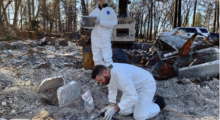
The public views President Jimmy Carter’s casket at the Carter Center in Atlanta on Jan. 5.
On this Presidents Day, with the recent death of former President Jimmy Carter fresh on our minds, the time seems apropos to take a close look at the official ways in which Americans honor the passing of their commanders in chief, and the extensive planning that goes into presidential funerals.
Organized under the purview of the Joint Task Force – National Capital Region and the US Army Military District of Washington (JTF-CR/USAMDW), presidential funerals follow many time-honored traditions. Yet many Americans remain unaware that incoming presidents are required to envision and plan their own funerals, updating those plans every three months.
Americans Have Bade Farewell to Four Past Presidents This Century
These include George H.W. Bush, 41st President (1924-2018), Gerald R. Ford, 38th President (1913-2006), Ronald Reagan, 40th President (1911-2004), and Jimmy Carter, 39th President (1924-2024). While there were many commonalities, each of them had to meticulously plan his unique period of mourning, from the route his funeral procession would take to where he would lie in state, to the seating chart at his funeral service.

The U.S. Air Force Band marches at President Gerald Ford’s funeral.
Credit: Bobby Jones
For example: President Reagan’s flag-draped casket was carried up the west stairs of the U.S. Capitol Building to symbolize his lasting connection to California, and he had funeral events in Washington D.C. and in California. President Ford was carried into the Capitol via the House side, to honor his years in Congress. He had events in Washington D.C., California and Michigan. President Carter’s funeral rites centered heavily on his hometown of Plains, GA, where he chose to be interred with Rosalynn, his wife of 77 years.
Certain things about a president’s death are standard. The period of mourning may last anywhere from three to 10 days, with events taking place in his home state, in Washington D.C. and in the state where he resided at his death. The process begins with an announcement of the past president’s death by proclamation by the current president. This triggers the Department of Defense to designate a commander, usually a high-ranking general, to coordinate the funeral proceedings through the U.S. Northern Command (NORCOM) out of Fort Lesley J. McNair outside Washington D.C. Since the president is the commander in chief of the armed forces, he gets full military honors.

The Joint Task Departure Force loads the casket of President George H.W. Bush.
Credit: Airman Michael S. Murphy
An elite honor guard and a military chaplain, as well as their own personal clergy, attend to the presidential family. Certain traditions affect the president’s funeral in Washington D.C. For example, his hearse, under police escort, stops at 16th Street and Constitution Ave. in Washington D.C., where his flag-draped casket is transferred by a nine-member team of mixed military pallbearers to a horse-drawn caisson (open carriage). This is in honor of the practice of using artillery caissons to carry the dead from battlefields, which served the US military until World War I.
The president’s funeral cortege includes an honor guard, honorary pallbearers, the national colors and the president’s color, clergy, the president’s family and a riderless horse with a pair of boots facing backward in the stirrups. The riderless horse, also called a caparisoned horse, signifies that the president’s march is complete. He is honored with a flyover of 21 tactical aircraft in missing man formation; 21-gun salutes in all 50 states; and three volleys fired over the president’s grave.
This last tradition harks back to the ancient Roman practice of casting dirt over a grave three times to signify that the funeral process is complete. The president then lies in state in his flag-draped casket at the U.S. Capitol Building for the public to pay its respects, and may also lie in repose in other significant buildings in his home state.

 U.S. Presidents’ Duties Include Planning Their Own Funerals
U.S. Presidents’ Duties Include Planning Their Own Funerals


 Recovering Cremation Remains After the Los Angeles Fires
Recovering Cremation Remains After the Los Angeles Fires
 “As Tears Go By” by Marianne Faithfull
“As Tears Go By” by Marianne Faithfull
 “The Sea” by John Banville
“The Sea” by John Banville














